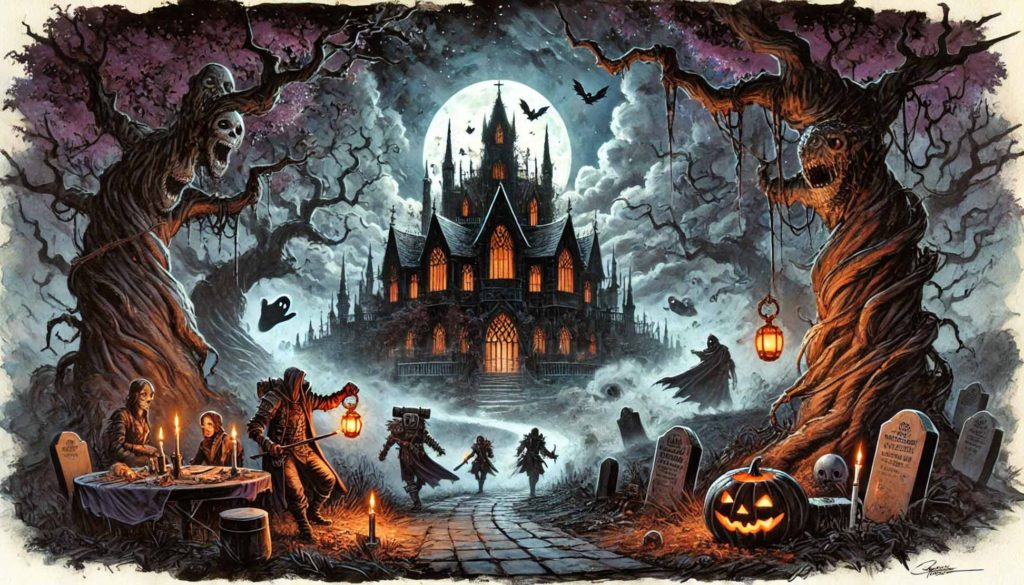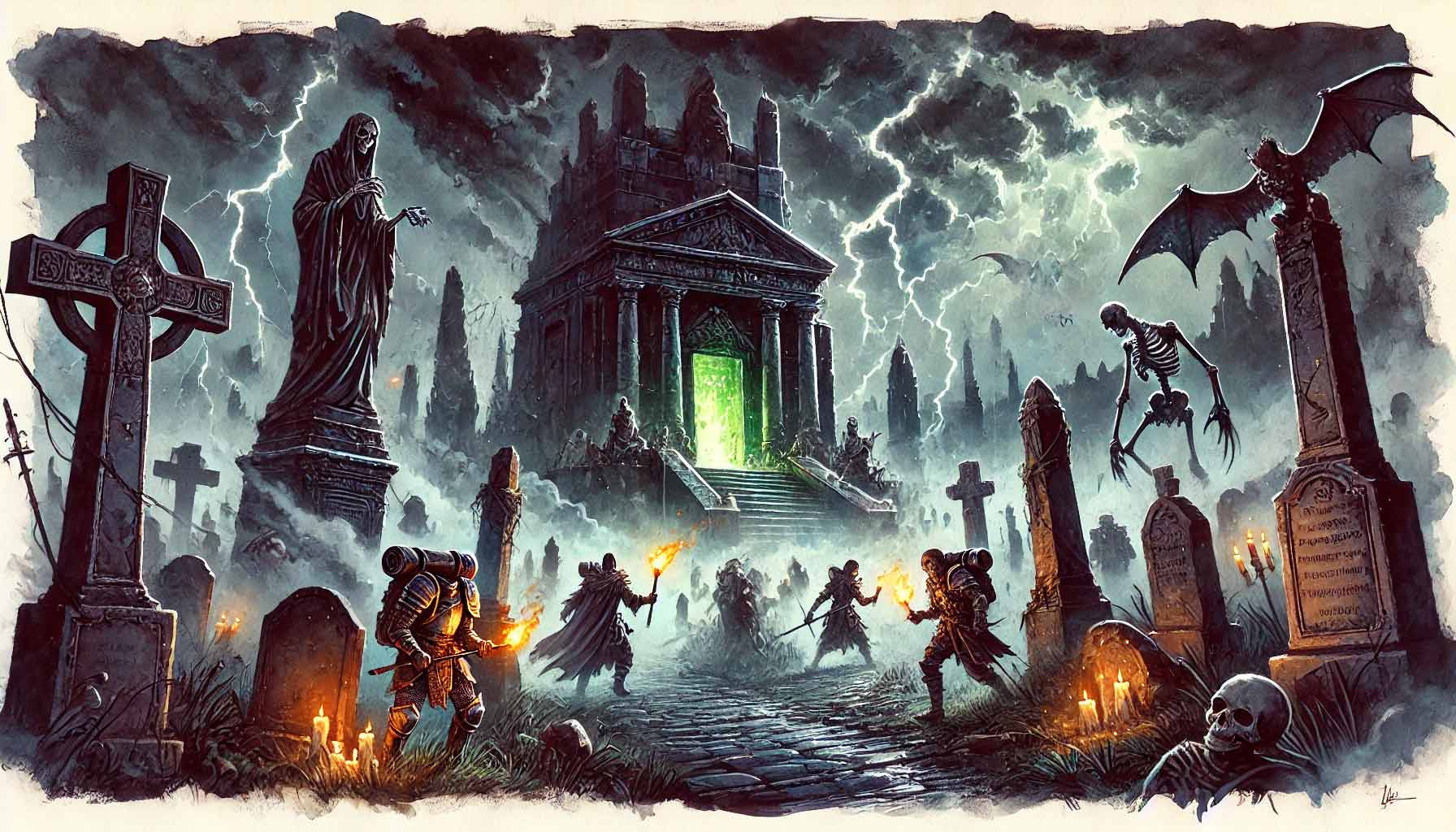Picture this: A crisp autumn night, the scent of pumpkin spice in the air, and a group of eager adventurers huddled around a table, ready to dive into a world of fantasy and fright. Welcome to the thrilling realm of Dungeons & Dragons Halloween one-shots, where the lines between horror and heroism blur in the most delightful ways.
Halloween-themed D&D one-shots offer a unique blend of spooky storytelling and fantastical roleplay. They’re the perfect way to celebrate the season, providing players with a chance to face their fears in a safe, imaginative space. These compact adventures pack all the punch of a full campaign into a single night of terror and triumph.
For Dungeon Masters, crafting a Halloween one-shot is an art form. It’s about striking the perfect balance between heart-pounding scares and engaging gameplay. You’re not just telling a story; you’re creating an immersive experience that will haunt your players’ memories long after the dice stop rolling.
Ready to unleash your inner horror maestro? Let’s delve into the dark arts of creating a D&D Halloween one-shot that will leave your players begging for more (while possibly sleeping with the lights on).
The Bones of a Haunting Tale: Essentials of a Halloween One-Shot
At its core, a great Halloween one-shot is like a perfectly carved jack-o’-lantern – it needs a strong structure to hold its eerie glow. The key is to distill the essence of both horror and D&D into a single session that’s as satisfying as it is scary.
First, consider your timeframe. Most one-shots run between 3-5 hours, so you’ll need to craft a story that can be told – beginning, middle, and end – within that window. This constraint actually works in your favor, forcing you to keep things tight and tension-filled.
Setting the Stage for Screams
Creating the right atmosphere is crucial for a Halloween one-shot. You’re not just running a game; you’re directing a horror movie in your players’ minds. Here’s how to set the stage:
- Use vivid, sensory descriptions to bring your spooky setting to life. Don’t just tell players what they see – describe the clammy touch of fog on their skin, the musty smell of ancient tombs, or the spine-tingling whispers that seem to come from nowhere and everywhere at once.
- Lighting matters, even in the real world. Dim the lights in your playing area and use candles (real or electric) to create flickering shadows. This simple trick can instantly transport players from their comfortable chairs into a world of lurking dangers.
- Sound can be your secret weapon. Create a playlist of subtle, creepy background music and sound effects. The distant howl of a wolf or the creak of old floorboards can do wonders for immersion.
- Encourage your players to lean into the Halloween spirit. Suggest they come in costume or bring themed snacks. The more everyone buys into the spooky atmosphere, the more memorable the experience will be.
⚔️ Fantasy RPG Random Tables Books
Make life as a Gamemaster easier…
If you play Dungeons & Dragons, Pathfinder, or other fantasy RPGs, this
RPG random tables series
is packed with encounters, NPCs, treasure, and more. Available in eBook or print—either way, you’ll have a wealth of adventure ideas at your fingertips.
Try my AI Tabletop RPG generators...and an extensive library of content!
Plotting Your Path Through the Shadows
When it comes to the story itself, you’ll want to hit those classic horror notes while still providing a uniquely D&D experience. Here are some elements to consider:
- Start with a hook that immediately sets the tone. Maybe the party is invited to a mysterious mansion for a Halloween feast, only to find themselves trapped inside with something sinister. Or perhaps they’re hired to investigate a village where children have been disappearing every Halloween for the past decade.
- Incorporate classic D&D elements with a horrific twist. A dungeon crawl becomes a terrifying descent into catacombs filled with restless spirits. A dragon might be an undead monstrosity, its breath weapon spewing necrotic energy instead of fire.
- Don’t shy away from horror tropes – embrace them! The fun comes from seeing how your players navigate these familiar scenarios with their unique abilities and personalities. Will the bard try to seduce the vampire? Will the barbarian attempt to rage their way through a ghost-infested hallway? These moments of levity can actually enhance the horror by providing contrast.
- Build in moments of quiet dread as well as pulse-pounding action. Horror is as much about what might happen as what does happen. Let your players’ imaginations work against them sometimes.
Remember, the goal is to create a story that could only exist in this beautiful mashup of D&D and Halloween. In our next section, we’ll explore how to maintain tension throughout your one-shot and design encounters that will have your players on the edge of their seats.
Keeping Players on Edge: Building Tension and Pacing
The heart of any good horror story is tension, and your D&D Halloween one-shot is no exception. The key is to create a rhythm of suspense and release that keeps your players engaged without overwhelming them.
Think of your one-shot as a roller coaster ride through a haunted house. You want moments of slow, creeping dread interspersed with sudden scares and bursts of action. This variety not only maintains interest but also makes the scary moments stand out even more.
The Art of Suspense: Pacing Your Adventure
Pacing is crucial in a one-shot, where time is limited and every moment counts. Here’s how to structure your session for maximum impact:
- Start strong with an attention-grabbing hook. Maybe the players witness a terrifying event or find themselves suddenly trapped in a spooky location. This sets the tone and immediately invests the players in the story.
- Alternate between exploration, social interaction, and combat. This variety keeps players on their toes and allows different character types to shine.
- Use environmental storytelling to build dread. Describe unsettling details – a portrait whose eyes seem to follow the characters, unexplained noises, or sudden drops in temperature. These small touches create a sense of unease without relying on constant action.
- Plan for at least one major plot twist or reveal midway through the session. This reinvigorates the story just when players might be getting comfortable.
- Build to a climactic finale that ties together the night’s events. This is where you pull out all the stops, combining challenging combat, high stakes, and the resolution of the central mystery.
⚔️ Fantasy RPG Random Tables Books
Make life as a Gamemaster easier…
If you play Dungeons & Dragons, Pathfinder, or other fantasy RPGs, this
RPG random tables series
is packed with encounters, NPCs, treasure, and more. Available in eBook or print—either way, you’ll have a wealth of adventure ideas at your fingertips.
Remember, in a one-shot, you don’t have the luxury of multiple sessions to develop your story. Be prepared to move the plot forward if players get stuck, perhaps by having an NPC provide a crucial clue or by having the threat come directly to the party.
Encounters and Challenges: Scaring Up Some Fun
Your encounters – whether they’re combat, social, or exploration-based – are the beating heart of your one-shot. Each should serve to either advance the plot, reveal important information, or ratchet up the fear factor.
- Design combat encounters that evoke the Halloween spirit. Instead of a simple fight against zombies, have the undead burst from graves in a foggy cemetery. Rather than just battling giant spiders, have the party navigate a massive web while dodging poisonous bites.
- Use the environment to add tension to fights. Maybe the room is slowly flooding, or the ritual site where the battle takes place is causing random magical effects.
- Create puzzles and traps with a spooky twist. A riddle told by a talking skull, a room where shadows come to life, or a chessboard where the pieces are ghosts can all add to the Halloween atmosphere.
- Don’t forget social encounters. Interrogating a suspicious villager, negotiating with a powerful witch, or trying to get information from a ghost with unfinished business can be just as thrilling as combat.
- Mix in skill challenges that test various abilities. Maybe the party needs to sneak through a sleeping vampire’s lair, research an ancient curse in a haunted library, or perform a ritual to banish an evil spirit.
The key is to keep your players guessing. If every encounter is a straightforward fight, the fear factor will quickly wear off. But if they never know whether opening a door will lead to a puzzle, a roleplaying opportunity, or a battle for their lives, they’ll approach each new challenge with a delicious mix of anticipation and dread.

Populating Your Nightmare: Characters and Monsters for Halloween
No Halloween adventure is complete without a cast of creepy characters and monstrous foes. This is your chance to really lean into the spooky season and create memorable NPCs and creatures that will haunt your players’ dreams.
Crafting Creepy NPCs
Your non-player characters are the heart and soul of your Halloween world. They provide atmosphere, advance the plot, and give your players people to interact with (and potentially fear). Here are some ideas to bring your NPCs to unlife:
- The Mysterious Caretaker: An old groundskeeper or butler who knows more than they let on. Are they helping the party, or serving a more sinister master?
- The Tragic Ghost: A spirit with unfinished business, perhaps a victim of the adventure’s villain. They could be a source of crucial information – if the party can help them find peace.
- The Creepy Child: Few things are as unsettling as a child who’s not quite right. Maybe they speak in riddles, have knowledge they shouldn’t, or are always accompanied by a shadowy figure only they can see.
- The Mad Scientist: A wizard or artificer whose experiments have gone too far. They might be the source of the adventure’s problem or a potential ally with questionable methods.
- The Cursed Villager: Someone transformed by a hex or dark magic. They could serve as a warning of what’s to come or a clue to the nature of the threat.
Remember, the key to a great NPC is consistency in their portrayal. Give each a distinct voice, mannerism, or quirk that players will remember. And don’t be afraid to ham it up a little – it is Halloween, after all!
Monsters and Mayhem
When it comes to creatures, D&D offers a treasure trove of spooky options. Here’s how to make the most of your monstrous encounters:
- Classic Horrors: Vampires, werewolves, and zombies are Halloween staples for a reason. Use them, but with a twist. Maybe your vampire is a child, forever frozen in time. Or your werewolves are an entire family, cursed for generations.
- Undead Terrors: Skeletons and ghosts are versatile foes. Describe them in vivid, unsettling detail. The skeleton of a massive beast reassembling itself, or a ghost that possesses objects to attack, can turn familiar monsters into fresh horrors.
- Eldritch Horrors: For a touch of cosmic horror, look to aberrations like gibbering mouthers or cloakers. Their alien nature and unsettling abilities can really amp up the fear factor.
- Corrupted Nature: Turn the natural world against your players with blights, fungal creatures, or animals twisted by dark magic.
- Custom Creations: Don’t be afraid to reskin existing monsters or create entirely new ones to fit your story. A pumpkin-headed scarecrow that animates at night, or a swarm of bats that forms into a humanoid shape, can be memorable encounters.
The key is to make each monster encounter meaningful. They shouldn’t just be bags of hit points to defeat, but integral parts of your story. Describe them vividly, play up their intelligence or bestial nature as appropriate, and let their presence add to the overall atmosphere of dread you’re creating.
⚔️ Fantasy RPG Random Tables Books
Make life as a Gamemaster easier…
If you play Dungeons & Dragons, Pathfinder, or other fantasy RPGs, this
RPG random tables series
is packed with encounters, NPCs, treasure, and more. Available in eBook or print—either way, you’ll have a wealth of adventure ideas at your fingertips.
The Grand Finale: Crafting an Unforgettable Climax
As your Halloween one-shot adventure reaches its peak, it’s time to pull out all the stops. The finale is where everything comes together – the atmosphere you’ve built, the tensions you’ve raised, and the story threads you’ve woven throughout the night. Here’s how to create a climax that will leave your players breathless:
Raising the Stakes
Your finale should present the highest stakes of the entire adventure. The fate of a village, the souls of the innocent, or even the fabric of reality itself might hang in the balance. Make it clear to your players that their actions here will have significant consequences.
Consider these elements to amp up the tension:
- Time Pressure: Add a ticking clock element. Maybe the ritual must be stopped before midnight, or the portal will close, trapping them forever.
- Moral Dilemmas: Force tough choices. The players might have to decide between saving a beloved NPC or stopping the villain.
- Twists and Reveals: Unveil a shocking truth that recontextualizes the entire adventure. Perhaps the true villain isn’t who they thought, or the nature of their quest is more sinister than they realized.
- Personal Stakes: Tie the outcome to the characters’ personal goals or fears. A character might face a corrupted version of a lost loved one, or confront a darkness within themselves.
The Final Showdown
The climactic encounter should be your most dramatic and challenging. It’s not just about difficulty, but about creating a memorable experience. Consider these ideas:
- Dynamic Environments: Set the scene in a location that can change during the battle. A crumbling castle, a ship in a storm, or a realm where reality itself is unstable can add excitement to the fight.
- Multi-Phase Battles: Have your final boss transform or change tactics mid-fight. This keeps players on their toes and feels suitably epic.
- Cinematic Moments: Design opportunities for heroic actions. Maybe a character needs to make a desperate leap to close a portal, or use an artifact at just the right moment to turn the tide.
- Involve the Whole Party: Create situations where every character’s unique abilities can shine. The rogue might need to disarm a trap while others hold off monsters, or the bard’s knowledge could be crucial to unraveling the villain’s defenses.
Remember, the goal is to create a satisfying conclusion that feels earned. The players should feel like their choices throughout the adventure have led to this moment.
The Aftermath: Wrapping Up Your Tale of Terror
Once the dust settles and the final die is rolled, it’s time to bring your Halloween one-shot to a close. A good ending should accomplish several things:
- Resolve the Immediate Threat: Make it clear how the players’ actions have affected the situation. Did they save the village? Banish the demon? Break the curse?
- Address Loose Ends: Briefly touch on the fate of key NPCs and locations. This gives a sense of closure and shows the wider impact of the adventure.
- Leave Room for Mystery: While resolving the main plot, you can leave a few questions unanswered or hint at future threats. This keeps the Halloween spirit alive even after the game ends.
- Acknowledge Character Journeys: Highlight how individual characters have been affected by the events. Maybe someone overcame a fear, learned a valuable lesson, or made a significant choice that will impact them going forward.
- Set the Final Tone: End with a description that encapsulates the mood of your adventure. It could be a scene of hard-won peace, a hint of lingering unease, or even a final jump scare to send players home with shivers.
Consider having players describe their characters’ actions in the aftermath. This not only gives them agency in wrapping up the story but can also provide wonderful, character-driven moments to end the night.
How Can Spooky One-Shot Adventure Ideas Enhance a D&D Halloween One-Shot?
Spooky dnd adventures bring an immersive, spine-chilling atmosphere to a D&D Halloween one-shot, making every encounter thrilling and unpredictable. Haunting narratives, eerie settings, and terrifying monsters heighten suspense, keeping players engaged. These adventures create unforgettable experiences, blending horror and mystery into a single eerie night of roleplaying excitement.
Embracing the Spirit of Halloween D&D
As you put the final touches on your spooky one-shot, remember that the true magic of a Halloween D&D adventure lies in the shared experience of facing fears and overcoming challenges together. It’s a chance for players to explore the darker side of fantasy in a safe, fun environment.
Don’t be afraid to embrace the campiness inherent in many Halloween tropes. A bit of humor can actually enhance the scarier moments by providing contrast and giving players a chance to release tension.
Most importantly, be flexible and responsive to your players. The best Halloween memories often come from unscripted moments – the nat 20 at the perfect dramatic moment, the unexpectedly hilarious response to a scary situation, or the creative solution to a problem you never anticipated.
So light those candles, set the mood, and prepare to take your players on a journey through the shadows. With the right mix of preparation and improvisation, your Halloween D&D one-shot will be an adventure they’ll never forget – no matter how hard they try!










